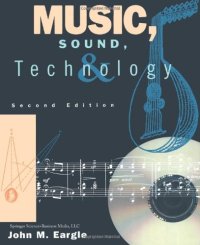
Ebook: Music, Sound, and Technology
Author: John M. Eargle (auth.)
- Tags: Music, Electrical Engineering, Biomedicine general
- Year: 1995
- Publisher: Springer US
- Edition: 2
- Language: English
- pdf
Since its publication in 1990, the first edition of Music, Sound, and Technology has enjoyed wide success and has become a popular text in musical acoustical studies at the university level. In preparing the new edition we have included recent developments in all aspects of music and sound technology, and we have added data on acoustical characteristics of musical in struments. The first edition has been cited for the scope and clarity of its graphics; we have emphasized this to an even greater degree in the second edition. /ME xi Preface to the First Edition This book is about music. the instruments and players who produce it. and the technologies that support it. Although much modern music is produced by electronic means. its underlying basis is still traditional acoustical sound production. and that broad topic provides the basis for this book. There are many fine books available that treat musical acoustics largely from the physical point of view. The approach taken here is to present only the fundamentals of musical phys ics. while giving special emphasis to the relation between instrument and player and stressing the characteristics of instruments that are of special concern to engineers and tech nicians involved in the fields of recording. sound reinforcement. and broadcasting. In order to understand musical instruments in their normal performance environments.
Since its publication in 1990, the first edition of Music, Sound and Technology has enjoyed wide success and has become a popular text in musical acoustical studies at the university level. Recording engineering expert John Eargle examines musical instruments, ensembles, and performance spaces in light of the latest technological developments in acoustics and sound recording. He masterfully delineates subject matter such as sound generation, the interrelation of musical instruments in performance environments, sound recording, psychological acoustics, and the impact of recent technology on music. Eargle's lucid writing and practical approach make the Second Edition a most valuable resource for sound professionals whose success depends on the handling of such everyday, yet crucial, tasks as proper mircophone placement, stage seating, instrumental balance, signal processing, and making adjustments in performance spaces. For recording engineers and other sound professionals, the book is also ideal as a college text in musical or communications studies